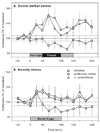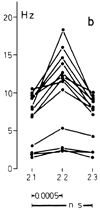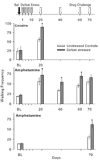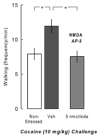Social stress, therapeutics and drug abuse: preclinical models of escalated and depressed intake
- PMID: 18789966
- PMCID: PMC2713609
- DOI: 10.1016/j.pharmthera.2008.07.006
Social stress, therapeutics and drug abuse: preclinical models of escalated and depressed intake
Abstract
The impact of ostensibly aversive social stresses on triggering, amplifying and prolonging intensely rewarding drug taking is an apparent contradiction in need of resolution. Social stress encompasses various types of significant life events ranging from maternal separation stress, brief episodes of social confrontations in adolescence and adulthood, to continuous subordination stress, each with its own behavioral and physiological profile. The neural circuit comprising the VTA-accumbens-PFC-amygdala is activated by brief episodes of social stress, which is critical for the DA-mediated behavioral sensitization and increased stimulant consumption. A second neural circuit comprising the raphe-PFC-hippocampus is activated by continuous subordination stress and other types of uncontrollable stress. In terms of the development of therapeutics, brief maternal separation stress has proven useful in characterizing compounds acting on subtypes of GABA, glutamate, serotonin and opioid receptors with anxiolytic potential. While large increases in alcohol and cocaine intake during adulthood have been seen after prolonged maternal separation experiences during the first two weeks of rodent life, these effects may be modulated by additional yet to be identified factors. Brief episodes of defeat stress can engender behavioral sensitization that is relevant to escalated and prolonged self-administration of stimulants and possibly opioids, whereas continuous subordination stress leads to anhedonia-like effects. Understanding the intracellular cascade of events for the transition from episodic to continuous social stress in infancy and adulthood may provide insight into the modulation of basic reward processes that are critical for addictive and affective disorders.
Figures
















Similar articles
-
Escalated or suppressed cocaine reward, tegmental BDNF, and accumbal dopamine caused by episodic versus continuous social stress in rats.J Neurosci. 2011 Jul 6;31(27):9848-57. doi: 10.1523/JNEUROSCI.0637-11.2011. J Neurosci. 2011. PMID: 21734276 Free PMC article.
-
Aggression and defeat: persistent effects on cocaine self-administration and gene expression in peptidergic and aminergic mesocorticolimbic circuits.Neurosci Biobehav Rev. 2004 Jan;27(8):787-802. doi: 10.1016/j.neubiorev.2003.11.005. Neurosci Biobehav Rev. 2004. PMID: 15019428 Review.
-
Social defeat stress and escalation of cocaine and alcohol consumption: Focus on CRF.Neurobiol Stress. 2018 Sep 19;9:151-165. doi: 10.1016/j.ynstr.2018.09.007. eCollection 2018 Nov. Neurobiol Stress. 2018. PMID: 30450381 Free PMC article. Review.
-
Gene expression in aminergic and peptidergic cells during aggression and defeat: relevance to violence, depression and drug abuse.Behav Genet. 2011 Nov;41(6):787-802. doi: 10.1007/s10519-011-9462-5. Epub 2011 Mar 17. Behav Genet. 2011. PMID: 21416141 Free PMC article. Review.
-
Two modes of intense cocaine bingeing: increased persistence after social defeat stress and increased rate of intake due to extended access conditions in rats.Psychopharmacology (Berl). 2009 Sep;206(1):109-20. doi: 10.1007/s00213-009-1584-6. Epub 2009 Jun 10. Psychopharmacology (Berl). 2009. PMID: 19513697 Free PMC article.
Cited by
-
Social stress models in depression research: what do they tell us?Cell Tissue Res. 2013 Oct;354(1):179-90. doi: 10.1007/s00441-013-1606-x. Epub 2013 Mar 27. Cell Tissue Res. 2013. PMID: 23532563 Free PMC article. Review.
-
Oxytocin Signaling as a Target to Block Social Defeat-Induced Increases in Drug Abuse Reward.Int J Mol Sci. 2021 Feb 27;22(5):2372. doi: 10.3390/ijms22052372. Int J Mol Sci. 2021. PMID: 33673448 Free PMC article. Review.
-
Sex differences in stress-induced social withdrawal: independence from adult gonadal hormones and inhibition of female phenotype by corncob bedding.Horm Behav. 2013 Mar;63(3):543-50. doi: 10.1016/j.yhbeh.2013.01.011. Epub 2013 Feb 4. Horm Behav. 2013. PMID: 23384773 Free PMC article.
-
The effects of repeated social defeat on long-term depressive-like behavior and short-term histone modifications in the hippocampus in male Sprague-Dawley rats.Psychopharmacology (Berl). 2010 Jul;211(1):69-77. doi: 10.1007/s00213-010-1869-9. Epub 2010 May 8. Psychopharmacology (Berl). 2010. PMID: 20454892
-
Social defeat stress in rats: escalation of cocaine and "speedball" binge self-administration, but not heroin.Psychopharmacology (Berl). 2011 May;215(1):165-75. doi: 10.1007/s00213-010-2139-6. Epub 2011 Jan 4. Psychopharmacology (Berl). 2011. PMID: 21197616 Free PMC article.
References
-
- Abbott DH, Keverne EB, Bercovitch FB, Shively CA, Mendoza SP, Saltzman W, et al. Are subordinates always stressed? A comparative analysis of rank differences in cortisol levels among primates. Horm Behav. 2003;43:67–82. - PubMed
-
- Ackerman SH, Hofer MA, Weiner H. Early maternal separation increases gastric ulcer risk in rats by producing a latent thermoregulatory disturbance. Science. 1978;201:373–376. - PubMed
-
- Adriani W, Chiarotti F, Laviola G. Elevated novelty seeking and peculiar d-amphetamine sensitization in periadolescent mice compared with adult mice. Behav Neurosci. 1998;112:1152–1166. - PubMed
-
- Allin JT, Banks EM. Effects of temperature on ultrasound production by infant albino rats. Dev Psychobiol. 1971;4:149–156. - PubMed
Publication types
MeSH terms
Substances
Grants and funding
LinkOut - more resources
Full Text Sources
Medical
Miscellaneous

